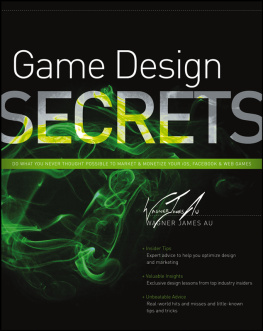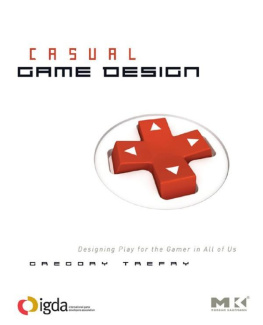Contents
Guide
Pagebreaks of the print version
Playful Thinking
Jesper Juul, Geoffrey Long, William Uricchio, and Mia Consalvo, editors
The Art of Failure: An Essay on the Pain of Playing Video Games, Jesper Juul, 2013
Uncertainty in Games, Greg Costikyan, 2013
Play Matters, Miguel Sicart, 2014
Works of Game: On the Aesthetics of Games and Art, John Sharp, 2015
How Games Move Us: Emotion by Design, Katherine Isbister, 2016
Playing Smart: On Games, Intelligence, and Artificial Intelligence, Julian Togelius, 2018
Fun, Taste, & Games: An Aesthetics of the Idle, Unproductive, and Otherwise Playful, John Sharp and David Thomas, 2019
Real Games: Whats Legitimate and Whats Not in Contemporary Video Games, Mia Consalvo and Christopher A. Paul, 2019
Achievement Relocked: Loss Aversion and Game Design, Geoffrey Engelstein, 2020
Achievement Relocked
Loss Aversion and Game Design
Geoffrey Engelstein
The MIT Press
Cambridge, Massachusetts
London, England
2020 Massachusetts Institute of Technology
All rights reserved. No part of this book may be reproduced in any form by any electronic or mechanical means (including photocopying, recording, or information storage and retrieval) without permission in writing from the publisher.
Library of Congress Cataloging-in-Publication Data
Names: Engelstein, Geoffrey, author.
Title: Achievement relocked : loss aversion and game design / Geoffrey Engelstein.
Description: Cambridge, MA : The MIT Press, [2019] | Series: Playful thinking | Includes bibliographical references and index.
Identifiers: LCCN 2019018577 | ISBN 9780262043533 (hardcover)
Subjects: LCSH: Video games--Design. | Computer games--Design. | Loss aversion. | Video games--Psychological aspects. | Computer games--Psychological aspects.
Classification: LCC GV1469.3 .E655 2019 | DDC 794.8/3--dc23
LC record available at https://lccn.loc.gov/2019018577
To Brian and Sydney, for turning losses into gains.
Contents
List of Figures
Loss aversion.
A character losing a level in Wizardry.
Tracking card from Hearthstone.
Portals weighted storage cube.
Weighted Companion Cube.
Emergency intelligence incinerator.
Pit Crew scoring track.
A portion of the scoring track in The Expanse.
Settlements, cities, and roads in the Settlers of Catan.
Cant Stop game in progress.
Bonus stars earned at the start of a Hearthstone season.
Allied operation wheel from The Fog of War.
Risk: Legacy box sticker.
Lost Cities.
Unit report from The Operational Art of War. The unit itself is composed of various assets, each of which has its own statistics (lower left).
Agricola score card.
A Feast for Odin player board. The 1 spaces can be seen in the grid on the left.
On Thinking Playfully
Many people (we series editors included) find video games exhilarating, but it can be just as interesting to ponder why that is so. What do video games do? What can they be used for? How do they work? How do they relate to the rest of the world? Why is play both so important and so powerful?
Playful Thinking is a series of short, readable, and argumentative books that share some playfulness and excitement with the games that they are about. Each book in the series is small enough to fit in a backpack or coat pocket, and each combines depth with readability for any reader interested in playing more thoughtfully or thinking more playfully. This includes, but is by no means limited to, academics, game makers, and curious players.
We are casting our net wide. Each book in our series provides a blend of new insights and interesting arguments with overviews of knowledge from game studies and other areas. You will see this reflected not just in the range of titles in our series, but in the range of authors creating them. Our basic assumption is simple: video games are such a flourishing medium that any new perspective on them is likely to show us things unseen or forgotten, including those from such unconventional voices as artists, philosophers, or specialists in other industries or fields of study. These books are bridge builders, cross-pollinating areas with new knowledge and new ways of thinking.
At its heart, this is what Playful Thinking is all about: new ways of thinking about games and new ways of using games to think about the rest of the world.
Jesper Juul
Geoffrey Long
William Uricchio
Mia Consalvo
Preface
For over ten years, I have done a segment called GameTek for the Dice Tower podcast. In this short segment, I take an aspect of math, science, psychology, history, or another discipline and relate it to the world of gaming. In the process of researching GameTek topics, Ive encountered a wide variety of psychology experiments that all point back to a core facet of the human experience: loss aversion. Im pleased to bring all these disparate threads into a single volume, to give designers another lens with which to view their designs.
The ideas presented in this book would not have been possible without many discussions with colleagues, students, and friends. My Ludology cohosts Ryan Sturm, Mike Fitzgerald, and Gil Hova were invaluable for challenging my ideas and bringing up examples and counterexamples. Thanks also to my game design colleagues Andrew Parks, Tim Fowers, Isaac Shalev, Mark Herman, Rob Daviau, Eric Zimmerman, Frank Lantz, Sen-Foong Lim, Grant Rodiek, Cole Wehrle, Ignacy Trzewiczek, and so many others. Tom Vasel provided the platform of the Dice Tower podcast, which allowed these ideas to germinate, and Josh Gaylord provided invaluable editorial and content commentary during the writing of this book.
Thanks also to the students in my New York University classes over the years, who have been subjected to a wide variety of the games and surveys mentioned in this book.
Finally, thanks to my children and codesigners Brian and Sydney for being sounding boards and keeping me connected with modern video game culture, and to my wife Susan for pushing me to write this book.
Introduction
Games are artificial. At their root, they are activities in which players agree to place obstacles in the way of achieving a goal. By doing this, they mutually collaborate to create a magic circle within which modes of action and interaction are strictly proscribed. A game must be designed. It is not something that is discovered; it is constructed.
Storytelling is another human construction that shares many characteristics with game design. Although there are various motivations for telling stories, including teaching about other people and places, giving examples of behaviors to emulate, and providing morals, the primary goal of the storyteller is to create emotion in the listenerto create for them an experience.
Similarly, game designers ultimately try to create an experience for their players. A game experience can be similar to a story, in which the players see the plot from the inside and can make choices that impact the final outcomesuch as Star Wars: Knights of the Old Republic,
But the designer does not need a traditional story framework or larger context to give players an experience. Games can tap into emotional needs as well, to put them into specific frames of mind. Chess makes players feel cerebral and in control; Magic: The Gathering In this sense, games occupy a similar place to film and can draw on emotional impact as well as story elements to create the desired player experience.



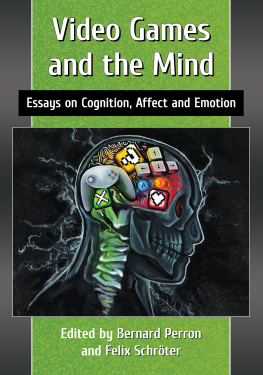
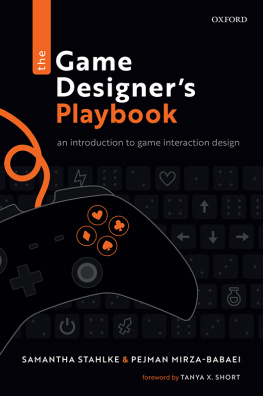
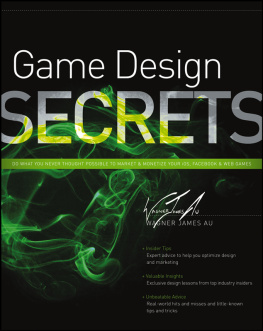
![Jesse Schell [Jesse Schell] - The Art of Game Design, 2nd Edition](/uploads/posts/book/119435/thumbs/jesse-schell-jesse-schell-the-art-of-game.jpg)
![Wagner James Au [Wagner James Au] - Game Design Secrets](/uploads/posts/book/119431/thumbs/wagner-james-au-wagner-james-au-game-design.jpg)
![Ethan Ham [Ethan Ham] - Tabletop Game Design for Video Game Designers](/uploads/posts/book/119417/thumbs/ethan-ham-ethan-ham-tabletop-game-design-for.jpg)
![Chris Bateman [Chris Bateman] - Beyond Game Design: Nine Steps Toward Creating Better Videogames](/uploads/posts/book/119409/thumbs/chris-bateman-chris-bateman-beyond-game-design.jpg)
